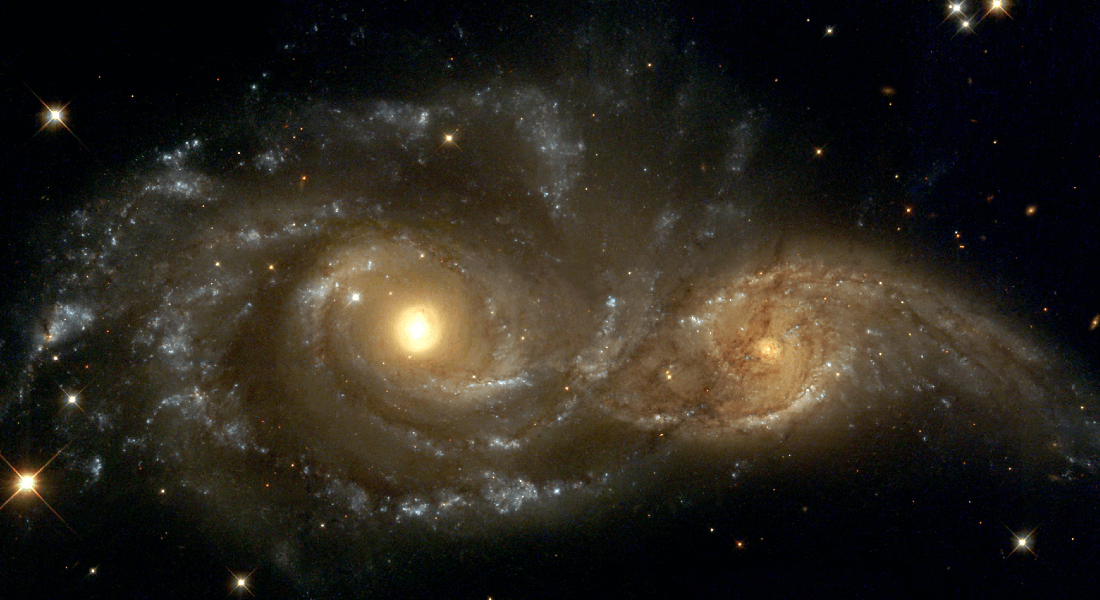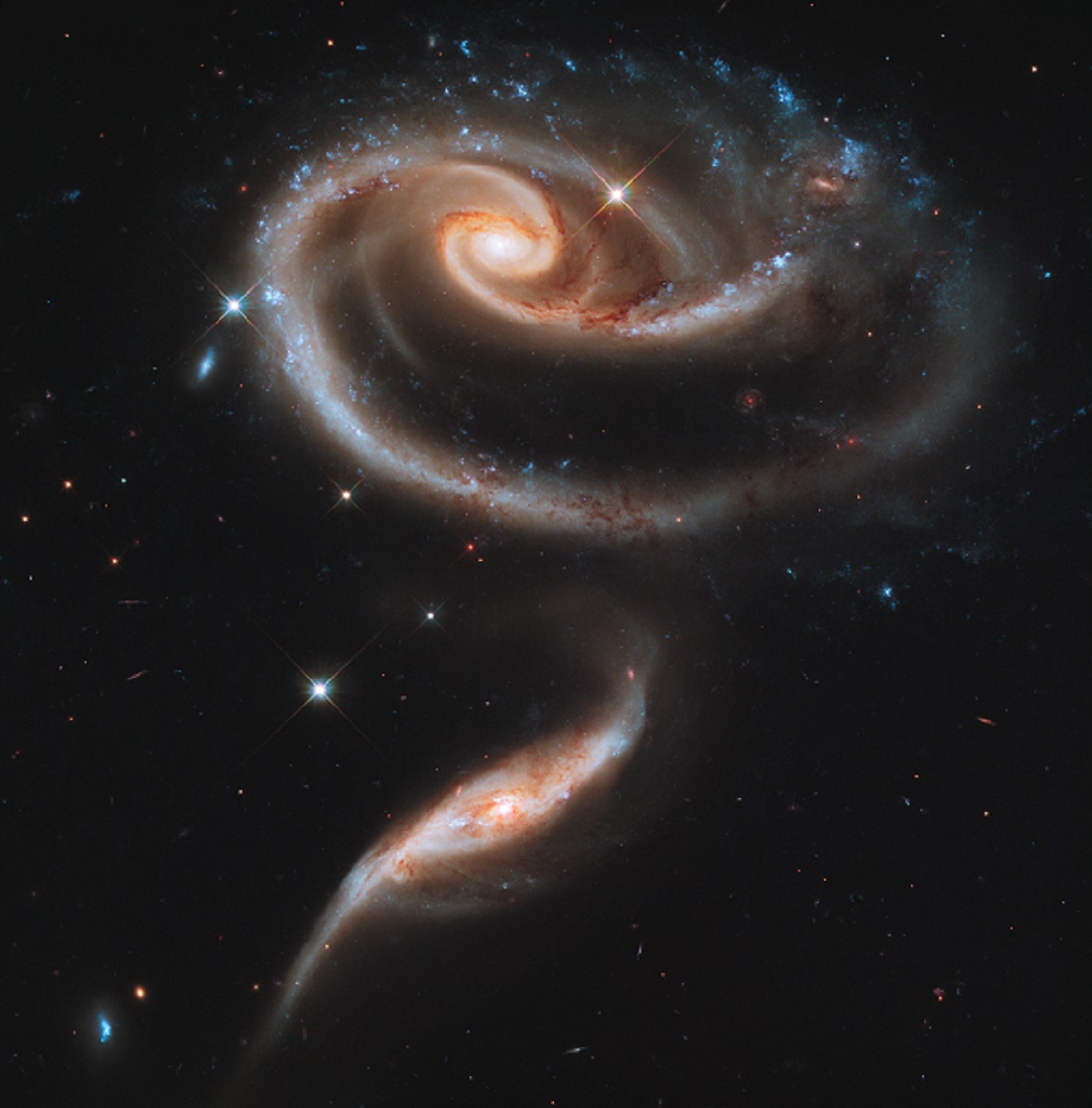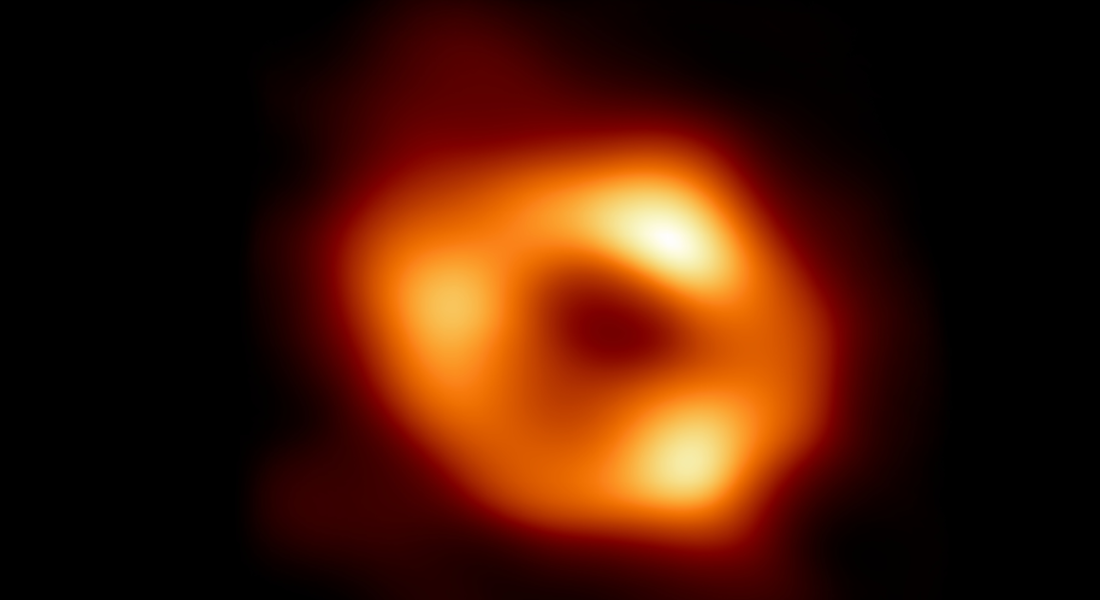Intergalactic gas brings supermassive black holes at the heart of galaxies to life
Black holes become active and grow by consuming gas captured from other galaxies. This is the finding of a new study from University of Copenhagen researchers, and shows a clear connection between the evolution of supermassive black holes and galactic interaction.

In the outer regions of the Milky Way, our blue planet rotates in its orbit around the Sun, the massive center of our Solar System. 26,000 light-years away, a supermassive black hole known as Sagittarius A* is at the center of our galaxy. It is a sleeping giant with a mass 4.3 million times greater than our sun.
Black holes are immense forces in the Universe. They can grow into supermassive giants — and can even be many thousands of times more massive than Sagittarius A* — by consuming large amounts of mass. But the mechanisms by which they grow have been a mystery to researchers.
Researchers from DARK at the Niels Bohr Institute, along with a colleague in the US, have now succeeded in demonstrating one effective way that activates black holes and feeds their insatiable appetites: This happens as they devour intergalactic gas transported from one galaxy to another – in connection with a galactic collision or as one galaxy passes close to another.
"Our observational data demonstrates that gas from galactic interactions can be transported through a galaxy and down to the black hole at the center of it. This will cause it to be activated. We see a direct connection between gas outside galaxies and the chance of active supermassive black holes," explains Sandra Raimundo, from DARK at the Niels Bohr Institute, who is the leading scientist of the study.
Understanding how gas reaches black holes has long been an unanswered question. The researchers in this study demonstrated one of these mechanisms.
The result is based on observations of 3,000 selected galaxies and marks the first time that researchers have obtained observational data as evidence for this mechanism that explains how black holes grow large.
"For a supermassive black hole to grow, gas must fall into it, which increases its mass. This is known as "accretion". When this happens, we consider a black hole to be active. We can observe this because as the gas heats up, it releases huge amounts of energy in the form of electromagnetic radiation, before plummeting into the black hole. This is something that we can measure from Earth,” explains Sandra Raimundo.
Gas out of step with galaxy
The new results are interesting to the researchers because they show that a larger proportion of galaxies have active black holes when gas is moving in the opposite direction of a galaxy's rotation, known as ‘misaligned gas’.
"These observations provide us with a clear link between interacting galaxies, ‘misaligned gas’ and active black holes, where gases are able to reach the centre of the galaxy and cause black holes to grow," says Sandra Raimundo.
Black holes
Light is unable to escape from black holes, nor can black holes be directly observed. However, large amounts of energy is emitted from gas rotating around active black holes, because that gas is heated by friction before falling in.
Three (-four) black holes categories:
- Stellar black holes: Form when stars initially more than 25 times the mass of the Sun collapse. With known examples being not much larger than Greater Copenhagen, they can be relatively small, but as all black holes extremely dense – with a mass between 3-100 times that of our sun. Researchers believe that there may be as many as 100 million of these in our galaxy alone.
- Medium size: For a long time, the category of medium size black holes (100-100,000 times the mass of the Sun) was a “missing link”, but in recent years, numerous credible candidates have been demonstrated.
- Supermassive black holes: 100,000 – 10 billion times the mass of the sun. Last year, an image of Sagittarius A* at the center of the Milky Way was obtained. Researchers believe that almost all galaxies have a supermassive black hole at their center.
- (?)There remains a great deal that we do not yet know about black holes, and the list of peculiar phenomena and theoretical categories is long. An important theoretical category that researchers expect to find, but which has yet to be observed, is known as Primordial Black Holes, which may have formed in the early universe. And some of which theoretically could be microscopic.
The study data also showed examples of active black holes where no misaligned gas was present in the galaxy, but where the supermassive black hole was still active. Therefore, the mechanism is not the only explanation for how supermassive black holes grow, but the data shows that it does play a significant role.
How the mechanism works is something that the researchers look forward to investigating in further research. For now, they only have theories and simulation data to explain what is happening. One thing that may play a role is that misaligned gas is unstable and out of orbit.
"Although misaligned gas comes with its own energy from rotation, its collision with opposing motions in the galaxy can cause the gas to lose that energy. In this way, the gas will be left to the gravity of the galactic core and could accelerate its fall towards the black hole at the center," explains Sandra Raimundo, lead author of the study.
Among other things, the research may help uncover yet another mystery, as supermassive black holes at the center of galaxies are thought to play a crucial role in regulating whether a galaxy generates new stars when they are active.
"In order to study how black holes and star formation in galaxies are connected, we first need to understand how black holes develop, when and how they become active. This study gets us a lot closer to such an understanding,” comments Marianne Vestergaard, one of the co-authors on the study, and she highlights:
"The exciting thing about these observations is that it is the first time it is possible to identify gas that has been captured from other galaxies and trace it all the way down to the center, where the black hole consumes it.”

It may happen here in a distant future
The supermassive black hole at the center of our own Milky Way is almost completely dormant and ingests very little gas. It is however possible that the misaligned gas mechanism will one day carry gas through our Milky Way and awaken the now calm Sagittarius A* at its center.
One way this could happen is from interaction with our neighboring galaxy, Andromeda which is heading our way and could collide with the Milky Way or pass close by in some 4.5 billion years. It is possible that gas from Andromeda could then find its way into the black hole at the center of the Milky Way.

For now perhaps we should be grateful for the low activity at the center of our galaxy, as high activity black holes can emit powerful radiation and high energy particles that, if they could reach us, could be harmful to life on our fragile blue planet.
About the study
Sandra Raimundo and her research team used telescope observations of over 3000 galaxies made by a research team in Australia.
The dataset matched the method of Raimundo’s research team because each galaxy had been observed and photographed and it included data on the speed of both gas and stars.
The analysis was performed by looking at the 3,000 galaxies and calculating how both gas and stars moved. They selected galaxies where the speed of the gas and the speed of the stars were out of step. They then looked at all the galaxies to find out which ones had active supermassive black holes.
In doing so, the researchers found a significantly larger proportion of the galaxies where they could detect gas that was misaligned with a galaxy's rotation - and thereby intergalactic - that had active black holes.
The researchers:
Sandra I. Raimundo - DARK, Niels Bohr Institute, University of Copenhagen,
Department of Physics and Astronomy, University of California,
and Department of Physics & Astronomy, University of Southampton.
Matthew Malkan - Department of Physics and Astronomy, University of California.
Marianne Vestergaard - DARK, Niels Bohr Institute, University of Copenhagen and Steward Observatory, University of Arizona, Tucson, AZ, USA
Contact
Assistent Professor at DARK Cosmology Centre
Niels Bohr Institute
University of Copenhagen,
sandra.raimundo@nbi.ku.dk
+45 35 33 16 59
Professor at DARK Cosmology Centre
Niels Bohr Institute
University of Copenhagen
mvester@nbi.ku.dk
+45 35 32 59 09
Kristian Bjørn-Hansen
Journalist and press contact
The Faculty of Natural and Life Sciences
University of Copenhagen
kbh@science.ku.dk
+45 93 51 60 02
